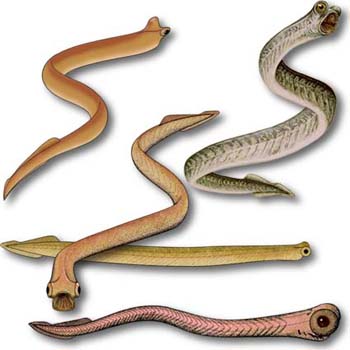Is it a monster? Or could it be something thought to have been extinct aeons ago?
In a shudder inducing post at Circus of The Spineless GrrlScientist describes a new species of bloodsucker from Amazonia that feeds on the mucous membranes in the nose:

As if most people don’t have enough blood-suckers in their lives, a new species of mucous-membrane infesting leech was discovered in the nostril of a 9-year-old girl. She frequently bathed in lakes, rivers and streams in the Amazonian part of Peru and was distressed when she felt “a sliding sensation” in the back of her nose.
The girl’s physician, Renzo Arauco-Brown, at the School of Medicine at the Universidad Peruana Cayetano Heredia in Lima, removed the leech and sent it to Mark Siddall, a leech expert and curator of Invertebrate Zoology at the American Museum of Natural History in New York City. Despite careful study, Dr Siddall and his colleagues were unable to place this specimen into any of the known leech families.
However, they did note that the specimen had eight very large teeth embedded in its jaw.
Hang on a minute -a jaw and teeth on a leech? Isn’t that evolutionarily and taxonomically unlikely?
Now I’m no evolutionary biologist, nor do I even play one on TV, but the first thing I thought when I read the species description was “That’s a conodont, surely”.
Conodonts are extinct chordates resembling eels, classified in the class Conodonta. For many years, they were known only from tooth-like microfossils now called conodont elements, found in isolation. Knowledge about soft tissues remains relatively sparse to this day. The animals are also called Conodontophora (conodont bearers) to avoid ambiguity.
The conodonts are currently classified in the phylum Chordata because their fins with fin rays, chevron-shaped muscles and notochord are characteristic of Chordata.
They are considered by Milsom and Rigby to be vertebrates similar in appearance to modern hagfish and lampreys, and phylogenetic analysis suggests that they are more derived than either of these groups. This analysis, however, comes with one caveat: early forms of conodonts, the protoconodonts, appear to form a distinct clade from the later paraconodonts and euconodonts. It appears likely that the protoconodonts represent a stem group to the phylum containing chaetognath worms, indicating that they are not close relatives of true conodonts.
Wouldn’t it be so cool if Tyranobdella turned out to be related to the conodont? And if the conodont is still about the place, what other lifeforms thought extinct millions of years ago are lurking in the planet’s more obscure corners?

